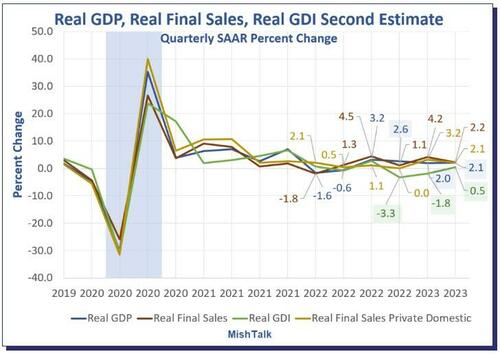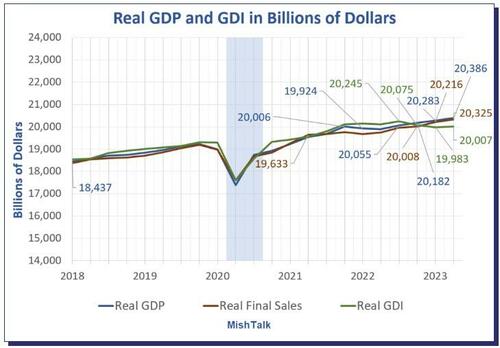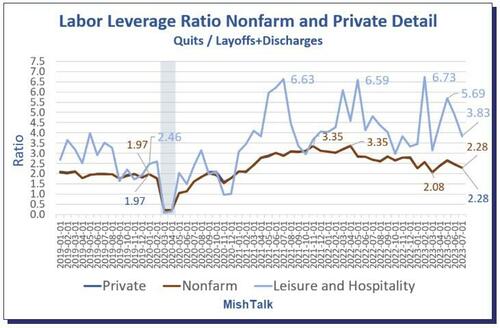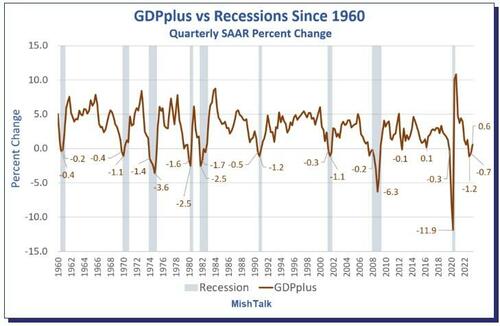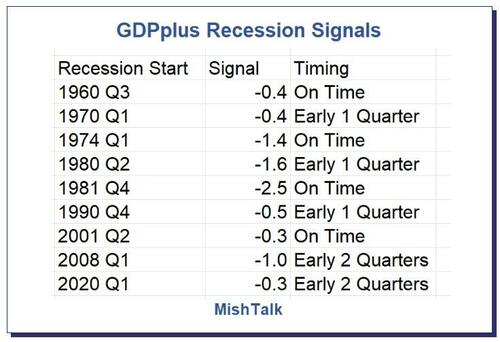Mainstream Media Finally Wakes Up To The Gaping GDP-GDI Recession Discrepancy
Authored by Mike Shedlock via MishTalk.com,
Not exactly timely, Bloomberg notes “The widening gap between gross domestic income and gross domestic product is a worrying signal.”
The difference between GDP and GDI is the biggest in US history. It should be identical, but it isn’t. pic.twitter.com/erjWHysI1g
— zerohedge (@zerohedge) August 30, 2023
GDP vs GDI Chart Notes
-
Real means inflation adjusted
-
GDP is Gross Domestic Product
-
GDI is Gross Domestic Income
-
Real Final Sales is the bottom line assessment of GDP. It excludes inventories which net to zero over time.
GDI was negative for two consecutive quarters and has been weaker than GDP for four quarters. GDI is now positive, but it is subject to greater revisions than GDP.
GDP numbers from the BEA, chart by Mish
Bloomberg opinion columnist Aaron Brown says Summer’s End Is Ushering In a Recessionary Chill, emphasis mine.
In theory, GDP and GDI measure the same thing — the total value of goods and services produced in a geographic area and sold to end-users at arms-length prices during a quarter — but in different ways. If the economy had a single cash register, GDP would measure the money coming into the till, GDI would measure where the money went — to wages, supplies, taxes, interest, dividends or left in the till for owners and stockholders. But since the economy has billions of transactions, many complex and not all captured in official numbers, GDP and GDI have different measurement errors, and thus different values. They’re usually pretty close, however, differing by 0.8% on average.
Using two successive down quarters as the signal for recession, from 1947 to 1973 GDP and GDI agreed all but once. They both signaled four recessions at the same times, and they both missed the 1961 recession. GDP did give one false alarm in 1947.
Since 1973, however, GDI has done much better. Four times it signaled recession before GDP and once it caught a recession that GDP missed. Twice the two triggered at the same time, and once GDP gave a false alarm.
There’s been more news recently suggesting that a recession began at the end of 2022. Second-quarter GDP growth was revised down. Job openings are plunging. The labor leverage ratio — the proportion of workers quitting to those let go by employers — is falling as well, suggesting workers fear a weak job market and have little power to get increased wages. Corporate profits are falling as well. If current trends continue, and if GDP declines a significant share of the roughly 1.5% needed to fall in line with GDI, the economic numbers released from late September through October could well prompt the NBER to announce a recession.
This has three main implications, two political and one economic. Politically, NBER declaring a recession would support the Republican story that the Biden administration hurt the economy and denied obvious economic reality for three years to push left-wing policies. It would make Democratic painting of Bidenomic prosperity seem hollow or even dishonest.
I have been talking about the GDP vs GDI discrepancy, negative revisions, the discrepancy between jobs and employment, corporate profits, and the job leverage ratio for months, and in far more detail. Let’s take a look at some of my recent posts.
Negative Revision to 2nd Quarter GDP, Huge Discrepancy with GDI Continues
The lead chart and the second chart are from my post Negative Revision to 2nd Quarter GDP, Huge Discrepancy with GDI Continues
Real GDI peaked in the third quarter of 2022.
Discrepancy Between Jobs and Employment
Employment levels and jobs data from the BLS, chart by Mish.
Payrolls vs Employment Gains Since May 2022
-
Nonfarm Payrolls: 4,377,000
-
Employment Level: +3,185,000
-
Full Time Employment: +1,446,000
-
Only 45.4 percent of the employment gains for the last 15 months was full time employment.
Jobs Rise by 187,000 But 110,000 Negative Revisions and Unemployment Soars by 514,000
On September 1, I noted Jobs Rise by 187,000 But 110,000 Negative Revisions and Unemployment Soars by 514,000
Accounting for negative revisions, jobs effectively increased by 77,000 while unemployment surges as people looking for work can’t find it. Bloomberg labeled this “Goldilocks”.
Unemployment rose by 514,000. Over half a million people wanted jobs but couldn’t find them.
Full time employment is down by 150,000 since January of 2023.
Here is a blurb I have posted in my monthly jobs reports for eight straight months.
Because of annual benchmark revisions, the way the BLS reports revisions, and the relatively small sample sizes of monthly jobs reports, we cannot, with strong confidence, suggest these reports portray an accurate picture of either jobs or employment.
Of the 894,000 rise in employment in January, 810,000 was due to annual benchmark revisions. And the BLS does not say what months were revised, just poof, here you go.
The monthly jobs report by the BLS samples a mere 6 percent of jobs. The Quarterly Census of Employment and Wages (QCEW) payroll employment data represents 95 percent of the data.
The BLS will not incorporate March of 2023 until January of 2024. Lovely.
The Labor Leverage Ratio, a Measure of Wage Bargaining Power, Is in Retreat
Data from the BLS, the Labor Leverage Ratio (LLR) is defined as Quits / (Layoffs + Discharges)
The BLS comments “the quits rate can serve as a measure of workers’ willingness or ability to leave jobs.”
The LLR is a refinement to the quits rate.
I have commented on labor leverage several times this year, most recently in The Labor Leverage Ratio, a Measure of Wage Bargaining Power, Is in Retreat
Philadelphia Fed GDPplus Measure Sure Looks Like Recession Started in 2022 Q4
The Philadelphia Fed has a measure called GDPplus that’s a blend of GDP and GDI, not an average. It appears to lean more heavily on GDI.
In 100 percent of the cases, with no false signals, no misses, and no lead times more than two quarters, every time GDPplus had two consecutive quarters of negative growth, the economy was in recession.
On closer inspection, all but once, and the exception was a mere -0.1 percent, every time GDPplus had one quarter of negative growth, the economy was or would soon go into recession. By soon, I mean within two quarters.
GDPplus accurately forecast the 1961 recession but GDP and GDI both did.
GDPplus Recession Signals
Mish compilation of recession lead times based on DGPplus data
GDPplus Recession Signals Synopsis
-
GDPplus signaled every recession
-
GDPplus was on time 4 times, early by a quarter 3 times, and early by 2 quarters twice.
This makes it appear as if GDPplus is a leading indicator. It isn’t because the data is heavily revised.
The BEA makes revisions frequently, especially on GDI. Since GDPplus is more reliant on GDI, it also has significant swings. However, GDPplus is the best recession indicator yet.
One quarter is sufficient and barring positive revisions to GDI and by implication GDPplus, the economy went into recession in the fourth quarter of 2022.
For more discussion of GDPplus, please see Philadelphia Fed GDPplus Measure Sure Looks Like Recession Started in 2022 Q4
Mainstream media is finally waking up to these discrepancies, albeit without any detailed analysis.
It’s quite possible a recession has come and gone. The NBER already had one instance of declaring a recession after it was over so don’t be surprised if it happens again.
It’s possible that a recession has come and gone with an interlude due to Inflation Reduction Act inflationary Nonsense.
If so, expect a rare double dip.
* * *
Tyler Durden
Tue, 09/05/2023 – 19:00
via ZeroHedge News https://www.zerohedge.com/economics/mainstream-media-finally-wakes-gaping-gdp-gdi-recession-discrepancy Tyler Durden
